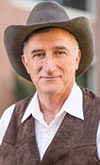As a rancher stated in a recent presentation made at the 2015 Range Beef Cow Symposium (2015 Range Beef Cow Symposium), “The area of production efficiency, and specifically feed efficiency, has plenty of room for improvement in the nation’s cow herd.”
Residual feed intake and rangeland adaptability
Recently, extensive research has been performed to classify beef cattle for their overall feed efficiency. Using specialized equipment, cattle are compared with respect to residual feed intake (RFI), which is expressed as the difference between expected feed intake (based upon bodyweight and growth) and actual feed intake.
Cattle with negative RFI scores consume less feed than expected and are classified as more efficient, while cattle with positive RFI scores consume more feed than expected and are classified as inefficient. Industry has embraced the adoption of using RFI data for bull purchases.
Despite the willingness of producers to adopt RFI as a measure of overall efficiency, little is known about how this trait (measured in a feedlot setting) affects beef cattle efficiency on rangeland. Will an efficient heifer (as ranked by a negative RFI score) also be efficient as a cow grazing rangeland?
Will it climb and utilize rugged rangeland as we hope it will do? Will the heifer maintain bodyweight and be fertile? These are a few of the questions we wanted to research at the University of Idaho. Since 2015, we have been gathering data to answer these questions.
To assist in this data collection, homemade grazing halters/collars have been successfully assembled at a fraction (16 percent) of the cost for commercially available collars. These homemade collars have a GPS logger for determining location, distance traveled, elevational gain, slope and distance from water; and a 3-axis accelerometer to determine grazing time, resting time and walking time (via head movement).
Accelerometers are used to help position rockets. If you have a smartphone, you are carrying around an accelerometer. It is the device that rotates your screen when the phone shifts position. Grazing locations and other GPS data are determined on five-minute intervals, and grazing activity (grazing, walking, resting) is evaluated every 0.4 second. We call this rocket science on the range.
Preliminary findings
2015 Study on Late Season Rangeland
We evaluated 2-year-old, first-calf heifers that had just weaned their first calf after being on irrigated pasture. All 30 heifers were shipped with the cow herd to sagebrush steppe rangeland at the USDA ARS Sheep Station in Dubois, Idaho, for fall grazing from Sept. 29, 2015, to Dec. 16, 2015. There was no protein supplement provided to any of the cows.
These rested pastures contained some greener grass in pasture swales that diminished over time. These cows had been previously evaluated for their feed efficiency as yearling heifers; 16 cows were classified as efficient, and 14 were classified as inefficient. When comparing these same heifers as 2-year-old cows, efficient animals were leaner (P less than 0.05) than inefficient heifers after weaning their calves (BCS = 5.8 plus or minus 0.1 versus 6.2 plus or minus 0.2).
However, the low-RFI cows lost less weight (P less than 0.05) than did the high-RFI cows during the rangeland grazing period. The low-RFI cows also experienced less variability in weight loss (Figure 1) over the late-fall grazing period.
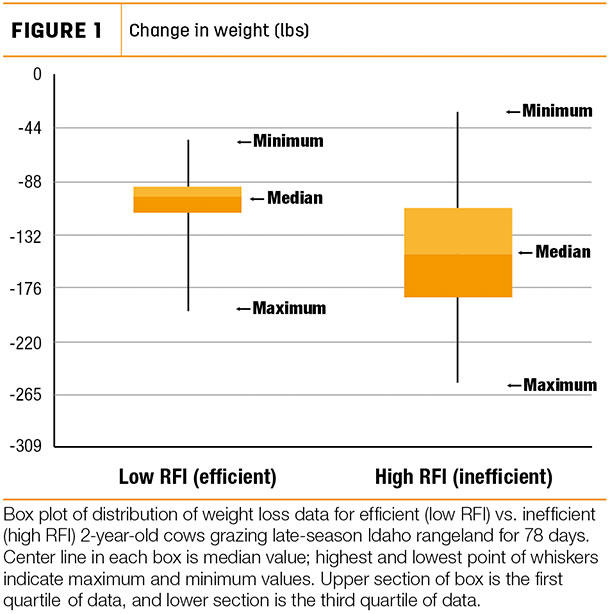
Based upon these findings, we desired to further evaluate similar types of cattle as lactating cows on rangeland.
2016 Study on Rangeland
We compared grazing behavior data among divergently ranked (12 efficient, 12 inefficient), lactating 2-year-old cows grazing rugged sagebrush steppe rangeland near Hailey, Idaho, in June and August 2016. When we looked at the averages for grazing time, resting time and walking time (Table 1), there was no difference in any of these measurements in either time period.
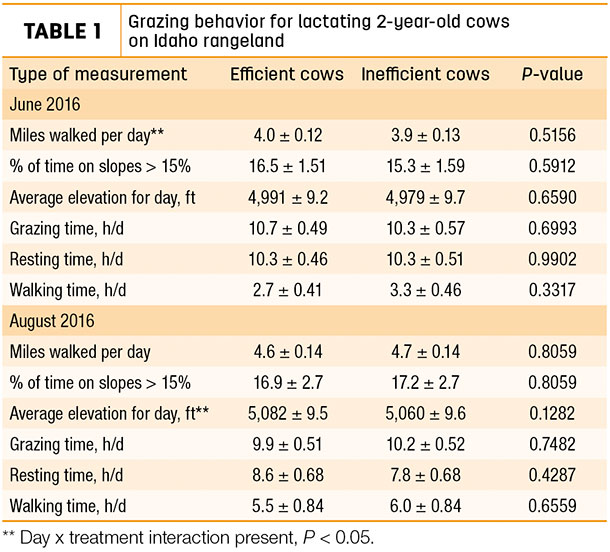 Similarly, there was no difference in the elevational gradient cows accessed.
Similarly, there was no difference in the elevational gradient cows accessed.
However, when cows were compared on the hottest days in August, striking differences emerged (Figure 2).
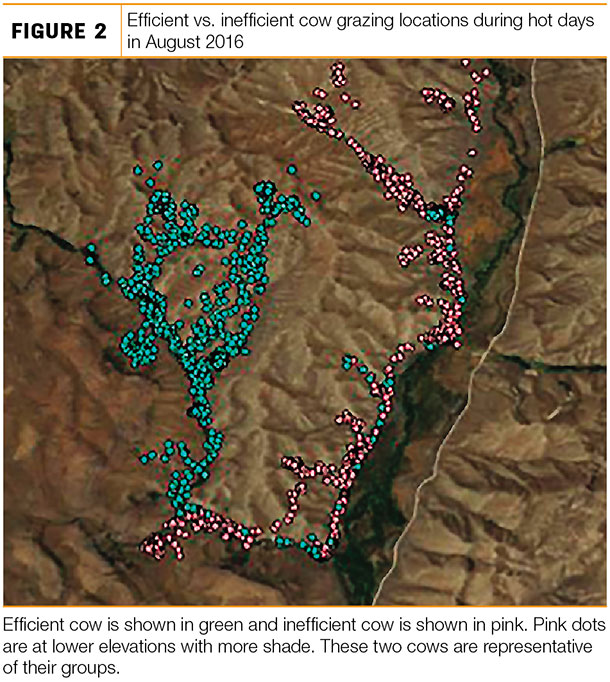 Inefficient cattle spent more time at lower elevations (P less 0.05 for day x treatment interaction for elevation) and presumably more time in the shade. There is actually a physiological reason for this difference in behavior.
Inefficient cattle spent more time at lower elevations (P less 0.05 for day x treatment interaction for elevation) and presumably more time in the shade. There is actually a physiological reason for this difference in behavior.
From my Ph.D. work at Texas A&M University, we discovered cattle with bigger appetites had bigger rumens, large intestines, smaller intestines, livers, etc. With a bigger “engine” comes greater heat, which is an advantage in cooler climates but obviously a disadvantage in hotter climates or on the hotter days of summer.
The divergently ranked cows in this study exhibited differences in behavior when experiencing mild heat loads during a seven-day period in June and a seven-day period in August. In this semi-arid environment with less humidity, the temperature-humidity index never exceeded the threshold necessary to move into a severe heat load.
Nevertheless, the days cows experienced mild heat load with limited cloud cover or wind were sufficient to cause changes in behavior between the efficient versus inefficient cows. On July 1, efficient cows walked 1.7 miles further than inefficient cows, and on July 3, they walked 1.4 miles further.
It should be mentioned: Inefficient cows did have one day during this time period (June 28) when they traveled 1 mile further than efficient cows. On that day, afternoon wind gusts prevailed for approximately four hours, starting at 3 p.m. On July 1 and July 3, efficient cows tended (P less than 0.1) to climb higher than inefficient cows.
Around the middle of August, the temperatures climbed to the mid- to upper 80s for about a week. For three of those seven days, efficient cows climbed significantly higher than did inefficient cows, and on one additional day, they tended (P less than 0.1) to climb higher. Other findings in our unpublished data suggest inefficient cows initiate grazing earlier in the afternoon when temperatures are not elevated, an indication of their greater appetite.
Conclusions
All of these results suggest during the hot days of summer, cows that have the genetics for improved feed efficiency also exhibit behavior to better access terrain and distribute more evenly on rangeland. On public land ranches with endangered fish or riparian area concerns, this adds further value to these efficiently ranked cows.
But what about production – do you have to take a hit on weaning weights with efficient cows? Early indications suggest this should not be a problem. Table 2 illustrates the results obtained for this small dataset of 2-year-old cows on Idaho rangeland in 2016.
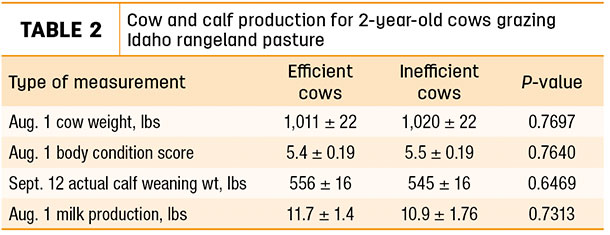
We are continuing this research and will not only be gathering production data over a period of years, we will also be evaluating fertility, longevity and profitability of divergently ranked cattle for feed efficiency in both an irrigated and rangeland environment. Stay tuned for more results in the future. ![]()
PHOTO: An experimental cow in Idaho carries a grazing halter in the first data collection period in June 2016. Photo courtesy of University of Idaho.

-
Jim Sprinkle
- Extension Beef Specialist - University of Idaho
- Nancy M. Cummings Research, Extension & Education Center
- Email Jim Sprinkle
